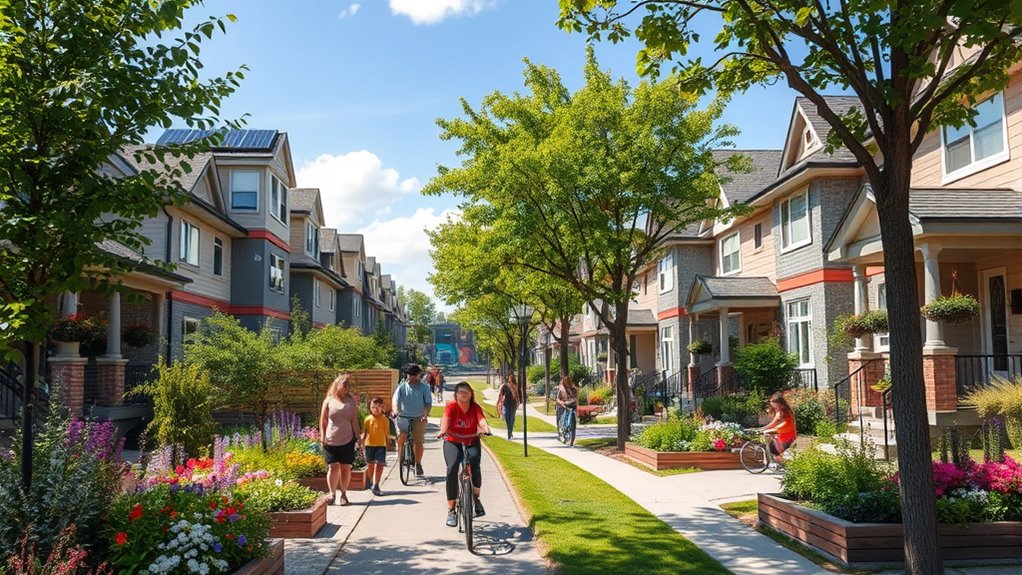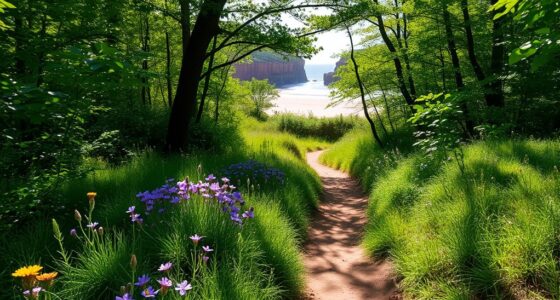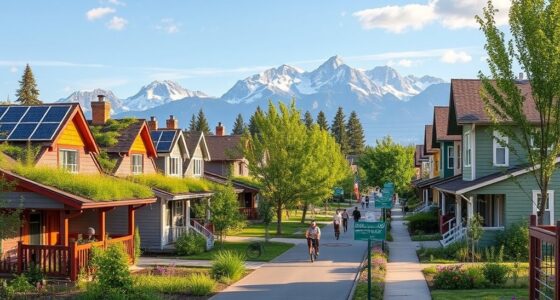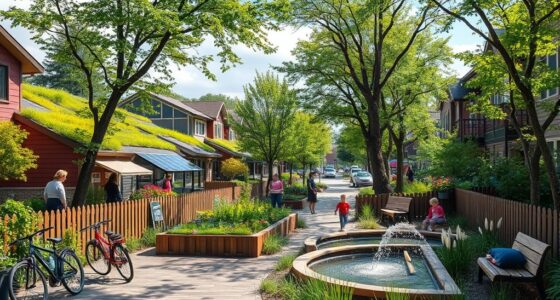In Winnipeg, you’ll find vibrant neighborhoods that prioritize sustainability. Assiniboine Park offers stunning green spaces and native plant landscaping, while the Exchange District showcases historic architecture integrated with solar energy. Wolseley’s tree-lined streets and eco-friendly homes create a welcoming atmosphere. Community gardens throughout the city not only foster local food production but also strengthen neighborhood bonds. Explore these areas to experience urban sustainability firsthand, and discover even more about what makes Winnipeg a green city.
Key Takeaways
- Explore Assiniboine Park for its beautiful gardens, walking paths, and sustainable practices promoting biodiversity and environmental awareness.
- Visit the Exchange District to see historic architecture combined with renewable energy initiatives, such as solar panels and energy-efficient lighting.
- Engage with community gardens that support local food production and foster neighborhood connections through workshops on sustainable gardening practices.
- Walk through Wolseley, known for its tree-lined streets and homes built with eco-friendly materials, enhancing air quality and wildlife habitats.
- Discover overall urban sustainability initiatives in Winnipeg, focusing on green spaces and renewable energy to create thriving, livable communities for future generations.
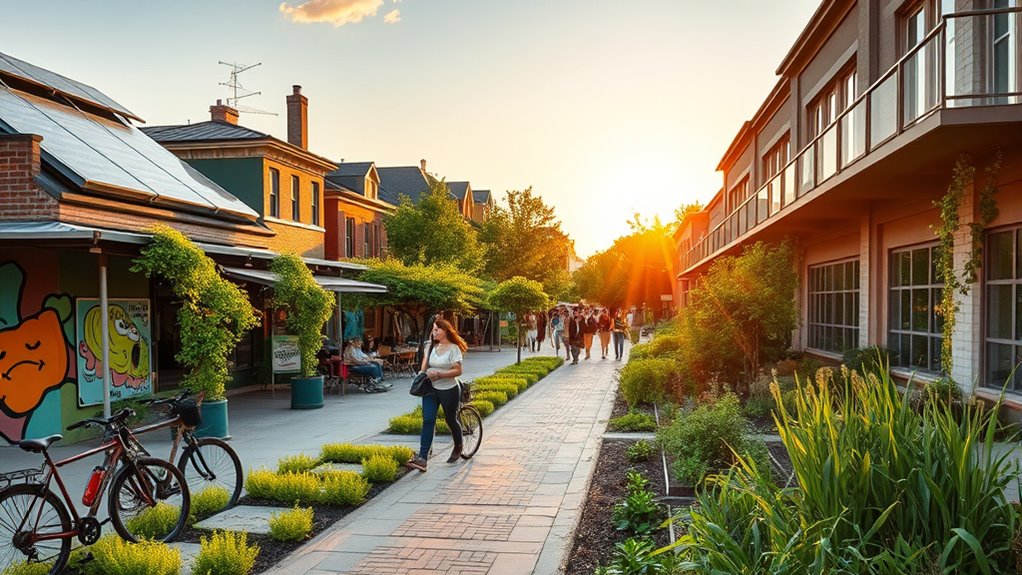
As you explore Winnipeg, you’ll discover that sustainable neighborhoods are not just a trend—they’re a commitment to a greener future. The city’s dedication to creating vibrant, eco-friendly spaces is evident in its numerous urban green spaces and innovative renewable energy initiatives. You’ll find that these areas not only enhance the beauty of the city but also foster a sense of community and well-being among residents.
Take a stroll through the Assiniboine Park, where sprawling lawns and well-maintained gardens offer an invigorating escape from the urban hustle. This park’s natural beauty is complemented by sustainable practices, such as water conservation and native plant landscaping, which emphasize the importance of biodiversity. As you wander along the walking paths, you can see how local initiatives encourage residents to engage with nature, promoting both environmental awareness and a healthier lifestyle.
Another area worth exploring is the Exchange District, known for its historic architecture and artistic vibe. Here, the city has embraced sustainable development by integrating renewable energy initiatives into the urban landscape. You might notice solar panels adorning rooftops and energy-efficient lighting illuminating the streets at night. These efforts reflect a collective commitment to reducing carbon footprints and fostering a cleaner environment, making the Exchange District a model for modern urban living.
In the West End, you’ll encounter community gardens that showcase the city’s efforts to promote local food production. These gardens not only provide fresh produce but also create a strong sense of community among residents. You can participate in workshops and events that educate people about sustainable gardening practices, further enhancing your connection to the neighborhood. This hands-on experience allows you to appreciate the importance of urban green spaces in enhancing food security and reducing waste.
Venture out to the Wolseley neighborhood, where tree-lined streets and eco-friendly homes create an inviting atmosphere. This area is a shining example of how sustainable architecture can blend seamlessly with nature. Many residents have invested in energy-efficient appliances and green building materials, showcasing their commitment to reducing their environmental impact. As you explore the streets, you’ll likely feel the positive energy that comes from living in a community dedicated to sustainability. Additionally, many of these neighborhoods are implementing urban green spaces that help improve air quality and provide habitats for local wildlife.
In Winnipeg, the push for sustainable neighborhoods isn’t just about aesthetics; it’s about creating a livable, thriving city for everyone. By embracing urban green spaces and renewable energy initiatives, you’re witnessing a transformation that aims to leave a lasting legacy for future generations.
Frequently Asked Questions
What Defines a Neighborhood as Sustainable in Winnipeg?
A neighborhood’s sustainability in Winnipeg is defined by its integration of urban green spaces and the use of renewable energy. You’ll notice how these areas promote biodiversity, enhance air quality, and provide residents with accessible parks. Renewable energy sources, like solar panels and wind turbines, reduce carbon footprints and foster energy independence. When you see a community prioritizing these elements, it’s a clear sign they’re committed to creating a sustainable future.
How Can I Get Involved in Sustainable Initiatives?
You can get involved in sustainable initiatives by volunteering at local community gardens or joining groups that focus on renewable energy projects. Look for workshops or events in your area that promote sustainability practices. Connecting with like-minded individuals can help you share knowledge and resources. Consider advocating for policies that support green initiatives in your community, and don’t forget to spread the word about the importance of sustainable living to your friends and family.
Are There Specific Events Focused on Sustainability in These Neighborhoods?
You won’t believe how many amazing events focused on sustainability happen in these neighborhoods! You can check out community gardens where locals gather to share tips and grow fresh produce. Don’t miss workshops on eco-friendly buildings, showcasing innovative designs that inspire everyone. Keep an eye on local calendars for sustainability fairs, tree-planting events, and green markets. Engaging in these activities not only enriches your knowledge but also strengthens community bonds!
What Transportation Options Are Available in These Sustainable Neighborhoods?
In these sustainable neighborhoods, you’ve got great transportation options. Public transit is easily accessible, making it simple to get around without a car. You’ll find well-developed biking infrastructure too, with dedicated bike lanes and paths that encourage cycling. This not only promotes a healthier lifestyle but also reduces your carbon footprint. So whether you prefer hopping on a bus or pedaling through the streets, you’ll find convenient choices for your daily commute.
How Do Sustainable Neighborhoods Impact Property Values in Winnipeg?
Sustainable neighborhoods can considerably boost property values in Winnipeg. When you invest in areas featuring green buildings and community gardens, you’re not just buying a home; you’re investing in a lifestyle. These amenities attract environmentally conscious buyers, creating demand and driving up prices. Plus, the sense of community fostered by shared green spaces enhances overall appeal, making these neighborhoods increasingly desirable, which positively impacts property values in the long run.
Conclusion
Exploring sustainable neighborhoods in Winnipeg isn’t just about seeing eco-friendly designs; it’s about experiencing a vibrant community committed to a greener future. Imagine strolling through lush parks, engaging with passionate locals, and discovering innovative projects that inspire change. By immersing yourself in these neighborhoods, you’re not only enjoying a unique adventure but also becoming part of a movement toward sustainability. So, why not step outside and see how these neighborhoods are shaping a better tomorrow for all?

